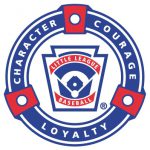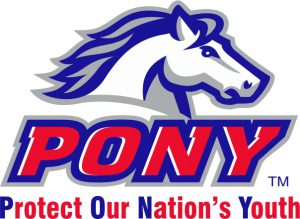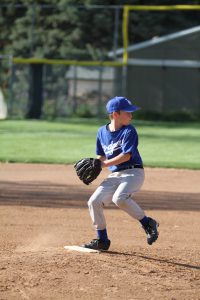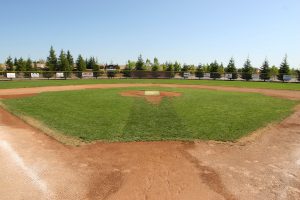I’ve heard quite a few parents asking around whether it’s better for their kids to play Little League baseball or Pony baseball. Some people don’t even know there’s a difference or that Pony baseball even exists. There is plenty of information online regarding the factual differences such as age requirements and field sizes, but having had my kids in both leagues, I can provide some insight on what I feel are the advantages and disadvantages of both leagues.
 First, let me explain the main differences of the leagues. Little League baseball has been around longer and has a much more well-known history and tradition. The ages of play conform somewhat to the design of typical baseball leagues where players are drafted by their ability and they have farm leagues, AA leagues, AAA leagues, minor leagues and major leagues. They also have T-ball divisions. In Little League baseball, ages can vary as much as three years in a division, with 9-year old players in a division with 12-year olds. This is decided by the player’s ability from the previous year of play and/or how they look in tryouts.
First, let me explain the main differences of the leagues. Little League baseball has been around longer and has a much more well-known history and tradition. The ages of play conform somewhat to the design of typical baseball leagues where players are drafted by their ability and they have farm leagues, AA leagues, AAA leagues, minor leagues and major leagues. They also have T-ball divisions. In Little League baseball, ages can vary as much as three years in a division, with 9-year old players in a division with 12-year olds. This is decided by the player’s ability from the previous year of play and/or how they look in tryouts.
 In Pony baseball, players are put into divisions by age groups of two years. They start in T-ball which is for 3 & 4 year-olds, then move up to Shetland division for 5 – 6 year olds, Pinto division for 7 – 8 year olds, Mustang division for 9 – 10 year olds, and so forth. Leagues have a little flexibility to make their own rules for playing up, but for the most part they stick to those guidelines. The thinking is that players won’t have that much difference in ability within a two-year span, so kids will be more comfortable playing in their leagues with other players closer to their own ages. While I disagree that the ability level doesn’t vary that much, there can be some advantages for the league to place players this way. First off, it’s not subjective, so no one is deciding what division the kids go into. Also, you know every year which division your child will be in, know what rules they will be under, and what equipment they will need.
In Pony baseball, players are put into divisions by age groups of two years. They start in T-ball which is for 3 & 4 year-olds, then move up to Shetland division for 5 – 6 year olds, Pinto division for 7 – 8 year olds, Mustang division for 9 – 10 year olds, and so forth. Leagues have a little flexibility to make their own rules for playing up, but for the most part they stick to those guidelines. The thinking is that players won’t have that much difference in ability within a two-year span, so kids will be more comfortable playing in their leagues with other players closer to their own ages. While I disagree that the ability level doesn’t vary that much, there can be some advantages for the league to place players this way. First off, it’s not subjective, so no one is deciding what division the kids go into. Also, you know every year which division your child will be in, know what rules they will be under, and what equipment they will need.
Next, there is the rules difference which was the reason we chose to have our kids play in Pony baseball to start their baseball careers. The two leagues are similar until the age of 9 – 10, and then Pony becomes more like real baseball with lead-offs, steals, and pitcher pick-offs. In Little League, the players don’t lead off or steal (unless there is a passed ball) until they are 13. Since my kids also played on travel teams, I feel they had a little advantage in knowing how to steal bases, and as pitchers they were able to develop pick-off moves a little earlier. The rules are the same for Pony baseball as they are for tournament play, so at this younger age, I think the Pony players have a slight advantage.
 At the age of 10 – 12, Little League has the major division which is the division that goes to the Little League World Series. Even though they can’t lead off and steal, the players are chosen for this division by ability and you may even have a couple of 9-year olds playing up in majors. In my opinion, this division is more competitive than the Pony Mustang and Bronco divisions because the best players are “pulled up” from the minors. Less talented players will stay in the minors at ages 9, 10, and 11. At age 12, players must be pulled up to majors. In Pony baseball the 9 – 10 division (Mustang) and the 11 – 12 division (Bronco) are made of players of every skill level, so the teams just aren’t as good. At the major division level, we decided to move our kids over to Little League because we just felt it would be more competitive for them, and we also liked the potential opportunity for the Little League World Series run. It’s just my opinion and some people may disagree.
At the age of 10 – 12, Little League has the major division which is the division that goes to the Little League World Series. Even though they can’t lead off and steal, the players are chosen for this division by ability and you may even have a couple of 9-year olds playing up in majors. In my opinion, this division is more competitive than the Pony Mustang and Bronco divisions because the best players are “pulled up” from the minors. Less talented players will stay in the minors at ages 9, 10, and 11. At age 12, players must be pulled up to majors. In Pony baseball the 9 – 10 division (Mustang) and the 11 – 12 division (Bronco) are made of players of every skill level, so the teams just aren’t as good. At the major division level, we decided to move our kids over to Little League because we just felt it would be more competitive for them, and we also liked the potential opportunity for the Little League World Series run. It’s just my opinion and some people may disagree.
 Another difference is the size of the diamonds between the two divisions. In Little League, children play on a diamond that has 60 feet between bases. At age 13 they move up to a full-size diamond that has 90 feet between bases. This can be quite a big jump, especially for a small 13-year old. Pony baseball scales the size of the diamonds to match the physical capabilities of the players within each division. Pony scales their diamonds as follows:
Another difference is the size of the diamonds between the two divisions. In Little League, children play on a diamond that has 60 feet between bases. At age 13 they move up to a full-size diamond that has 90 feet between bases. This can be quite a big jump, especially for a small 13-year old. Pony baseball scales the size of the diamonds to match the physical capabilities of the players within each division. Pony scales their diamonds as follows:
- 50ft bases for Shetland 5 & 6 year olds
- 60ft bases and 38ft pitching for Pinto 7 & 8 year olds
- 65ft bases and 44ft pitching for Mustang 9 & 10 year olds
- 70ft bases and 48ft pitching for Bronco 11 & 12 year olds
- 80ft bases and 54ft pitching for Pony 13 & 14 year olds
This makes some sense because the younger kids can get used to pitching from a little longer distances as they grow. I don’t really feel like it makes a whole lot of difference until the 13-year old age, when the jump is larger for Little League. If your child also plays travel ball, these same distances apply.
There are upper divisions in both leagues for kids 13 and up. In Little League there is also an intermediate division which has 70 foot bases and 50 foot pitching, very similar to Pony Bronco. The rules are the same with lead-offs and steals, but many leagues don’t offer the intermediate division because of the lack of enough players. The junior division is for kids 12 – 14 years of age, similar to the Pony division in Pony baseball, and the senior division is for 13 – 16-year olds, similar to the Pony Colt division. Pony and Little League also have divisions that go beyond age 16. For both Little Leagues and Pony leagues, the numbers of kids signing up dwindles at these ages because many of them go off to play high school ball. These can be great, fun leagues for kids who don’t make the high school teams or just want to play for fun.
 I always felt like the mentality of the parents was very competitive in Pony league in the younger divisions. At the league where our kids played, the Shetland and Pinto divisions were always very good, but this lead to some kids not playing as much. Some of the coach dads were more concerned with winning than developing players, so the less talented players got left in the dust. I think that if you want your child to learn and have fun that Little League is probably a better bet, especially if he or she is not a stud athlete. I think you will get some of that “Daddy ball” mentality at any league you go to, but in my opinion, it’s just more prevalent in Pony ball.
I always felt like the mentality of the parents was very competitive in Pony league in the younger divisions. At the league where our kids played, the Shetland and Pinto divisions were always very good, but this lead to some kids not playing as much. Some of the coach dads were more concerned with winning than developing players, so the less talented players got left in the dust. I think that if you want your child to learn and have fun that Little League is probably a better bet, especially if he or she is not a stud athlete. I think you will get some of that “Daddy ball” mentality at any league you go to, but in my opinion, it’s just more prevalent in Pony ball.
So in summary, the way we did it was to have our kids play at the Pony league until the age of 11. At that point we moved them to Little League in the major division. You will want to check with your leagues for local boundaries because they can be strict as far as where you live or where your child goes to school, especially for Little League. Pony boundaries are more relaxed, but some may restrict your child’s options. Also, at age 11, our kids had to compete in tryouts to make the major division, unlike Pony where they were placed there based on age. We are very comfortable with the decision we made to move them, and I wouldn’t change it if I had it to do over again.

LL for those kids who struggle.
PONY for those kids who’s skills are above LL. PONY gets you ready for travel ball and High School.
Yep, I agree with that take. 🙂
As far as skill level, it doesn’t get any better than Little League baseball. If you watch the Little League World Series, you just aren’t going to get any better quality in Youth Baseball than that. Compare pitching speeds, ability, tactics, etc. LLWS teams would obliterate most average high school teams! Most Major Leaguers played Little League baseball. Not Pony League. Just saying. ?
Pony champs would school LL champs any year.
You think? 😀
I played for the pal little league team at McMillen park in 1969.myron Myers was our coach
Lookin for anyone that played on the McMillen park pal baseball team in 1968.myron Myers was our coach.if anybody has any info or knows any one from that team contact Kenny Brooks 602-473-7972
Just depends on the individual’s ability and motivation. I’ve seen PONY kids “struggle” as much as LL
Good point. 🙂
Looking to sign up my boy for 14U
somewhere in the Corpus Christi Area
Plz email me.
Hello. If you have questions, please email me at contact@BaseballMomStuff.com.
Pony is way more competitive play then LL. If you really want to jump start your kids skills and develop to hopefully make their high school team. Little league is good up until caps/rookies cause its just fun at this point.
Pony is not driven by age alone. At each age group there are two levels of play. Players (9-10) or teams can play at a more competitive level such as Mustang or a more developmental level called Yearling. Every age group from age 7+ offer this option to organizers. Teams cooperate to help place skilled players at the correct level of play. If a team decides to play developmental level but has a player that is ready to play up, then they collaborate with the teams to get the player onto the level appropriate for the child.
LL and Pony both claim to use assessments to determine skills but that is inconsistent from one area to another.
One of the best features of Pony is the geographical boundaries are based on individual school districts while LL uses a lottery system to “draft” players on to teams. LL includes several school districts per LL organization. This article has that backwards. The Pony individual school system approach allows classmates to play together and allows teams to stay together over a period of years. It also creates inter-school rivalries just like high school. LL requires political connections to keep teams together year after year. Again, this varies from one region to another.
Totally agree on the point about the field sizes. LL should offer a more gradual jump at age 13. Pony uses 80′ bases at that age allowing another two years before reaching the full 90′ base path.
Each league has pros and cons. I prefer Pony primarily for the ability for classmates to play together and compete against local schools. LL is well run and has a number of nice features. The centralized registration allows for consistent administration across all teams in that regional organization. Pony suffers from decentralized administration by individual associations representing a single school district. The processes and capabilities of the associations can vary greatly. School districts with no association are open, allowing the players to play for any adjacent associations. Associations cooperate to help ensure that any kid that wants to play can play.
Very interesting info. When my kids played for the local Pony league, they didn’t have a “yearling” option and they were very strict about players moving up based on skill level. In all the years my kids played there (about 7 years) I never saw one kid being moved up. The board members always said if they let one kid do it, it would open the floodgates and they would have to start letting more kids do it and they didn’t want that. I think it would have been good for a few kids we had there who were really good and had to play in their age divisions which were not good enough for them.
I’m not sure what you mean by the individual school districts for Pony. Our pony league had no boundaries, so kids could come from anywhere and play there, but if they were from another league’s boundaries, the other league could dispute them playing All Stars. You are absolutely right about the political connections in Little League, but I’ve seen it in Pony as well. Thanks for your comments. 🙂
Not only does each league have its pros and cons but it also depends on where you live. In my area, LL is more elementary and the coaches are not as skilled as PONY. Where I live, PONY is much more serious when it comes to developing skilled players. My son is not only learning how to play the game but how to play smart as well. He’s been switch hitting, stealing bases (they always make him go back because it’s not allowed yet lol), and sliding since age 4 and I owe that to our wonderful coaches who care to go that far with our kids. We also have PAL which is more on a recreation level than anything else in my city. I chose PONY for my son because the dedication of the league and parents is unmatched and I want him to be as prepared as possible for travel ball (which most kids in our PONY league do). Again, I think it’s going to vary by city because the people running the leagues and managing the teams do matter a lot and makes a huge difference. LL may be stronger in one city than PONY and the other way around in the next city. I chose PONY because I’ve had brothers in all three leagues in my city and PONY was the closest to real baseball and had the strongest sense of community that I wanted for my son. We play PONY for fall ball and spring season and my son is just in love with it. I would say do your research for each league where you live before making a decision.
Great comments Mama Nat! 🙂
Coming from a Southern California perspective. We play Pony. Currently in the first year of the Mustang (9-10 year olds) division. While it is true that there is a mix of player capabilities, our league as do many around us, have American and National divisions within each age group. The kids who are generally evaluated as the top 20-25 kids in each division will play American or “A” ball. These kids get to play other neighboring Pony leagues vs their A clubs. It is like having a travel experience within a Rec season. The National kids will play by slightly different rules than the American kids thereby allowing for more development and less pressure while getting to play with kids their same age and grade. It is similar to the A, AA and AAA minor league program you will see in LL but the age gap is only a year rather than up to 4 years. The gradual increase in the field size is key. It allows for kids to work up their arm strength and maybe even hit a ball over a fence for a home run. It really is a great program and you do get the true game experience very early on. In Pony you will also get a chance to play in Cooperstown for a week when you are 12-16 years old. If your league has a ticket, it is an amazing experience. Ultimately I would say go watch a couple games of Pony and LL baseball in your area for the same age groups and see how the game is played. I have seen 7 year old Pony teams (Shetland) who would destroy a AA LL team with 9 and 10 year olds on it. It is fun to watch and coach higher level baseball at an early age. I played LL as a youth and in retrospect, I think I would have grown as a player more in Pony rather than being stagnant for several years of the same kind of baseball in LL.
Bottom line: do what is best for your son or daughter and his or her level of interest and commitment and assess his or her interest in playing with friends from school. You are not locked in. If you don’t like one league, try the other. But definitely GO WATCH! Maybe the grass is greener.
These are great insights. I sure wish our Pony league would have had American and National division like that. It sure would have made it better for the more talented kids, however, I don’t think we would have had enough kids in the league to do it. There wouldn’t have been enough for all of the team. I love the idea though. My kids actually played both Pony and Little League and I see different benefits in both. 🙂
I am researching this for my grandson. He is 7. I coached my daughter from 5 yo to her high school practice teams. I was on our girls softball league board for 7 years and president for 2 of those. Felt it was my way of paying back. Our association was ASA controlled. During my growing up there was LL and then PONY/Colt was where you went at 13. Our LL district just switched from 30+ years of LL to becoming a PONY league. Knowing the parents here, I can see that they want to play more “travel” ball. To me travel ball sucks the leagues out of all but the least talented. It happened earlier with the girls, but the boys have caught up. That’s not always good.
Any Dad that gets cross with the league or his kid doesn’t get what HE wants often move to travel to start their own team. There often are more teams than there are players so the coaches will ask intermediate players to play travel. Our girls league once had 400 kids, now it’s down to under 200. Travel ball is alive and well in our area.
Appreciate the input as I didn’t know why our city switched to Pony. Being more competitive and more freedom to play travel makes some sense. Best of luck, my experience is take it easy, they are just kids. Most of this will just be a memory for you and them, good or bad.
Very well said, Robert. It makes me sad that travel ball is killing the leagues because the local baseball field is a great place for a kid to grow up. But, it’s a competitive world and everyone wants their kid to have an edge. Having fun should be just as important. <3
You played ASA, did you ever play Bobby Socks? I like to compare LL to BS and Pony to ASA. In southern California Pony is far better than LL. WE have many players who were drafted by MLB and college full rides. When LL tried to switch over they had a hard time adapting to MLB rules than out kids who played at early age. My son’s 8U travel team swept the inaugural 8u Triple A world series. No one even came close to our level of play. Or coach was so top notch and both his boys now pitch for MLB. The Reds and Angels organization. We do not have much of a LL following in our area. I believe it all is the area you live and the following. I did want my son to play in the LLWS. Just would never happen in our area
Great article. I agree with pretty much everything. It’s really hard to say one is better than the other. It depends largely on the leagues and the volunteers of that league. My oldest son played LL from T-Ball thru Majors. At that point we realized the Jrs division in our area was horrible. I think it was much to do with that huge jump in distances, TBH. He went to Pony and the Pony Division, and it was awesome. Night and day at that level. My youngest started that same year in Pony t-ball. The ages for divisions also varies by league. Our Pony league is 2-year increments, but going “up” by one year only takes a request, and going up by two years takes a tryout. On the flip side, what I saw in LL on the age-ranges got a bit absurd. 11 yr olds staying down in AAA just so their dads could coach into the championship. 12 yr olds missing assessments and getting stuck playing with 9 yr olds. When I took my kids to Pony, I also took my own coaching time, as well as my volunteering as a board member. Pony rules are a lot more lenient on the league level, so if you have the right guys in charge (I was President for 7 yrs) you can set league rules pretty much how you want to and really get it right (or wrong). In LL you’re very much stuck with strict LL international rules. A little leniency with what you do at the low levels, that’s about it.
Does EVERY child that trys out make a team? Also, does Pony have a league, division, or what every you want to call it, for special needs players?
In the Pony league where my kids played, every kid who tried out was placed on a team. That league didn’t have a division for special needs players, but our local Little League has the Challenger Division which is specifically for special needs kids and adults.